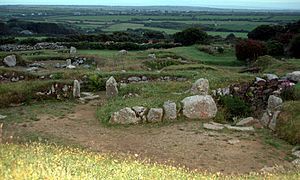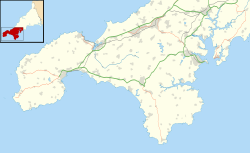Carn Euny facts for kids
|
Cornish: Chapeluni
|
|

Carn Euny ancient village
|
|
| Location | Brane, Cornwall |
|---|---|
| Coordinates | 50°06′08″N 5°38′04″W / 50.10234°N 5.63448°W |
| Type | Ancient village |
| History | |
| Founded | c. 200 BC |
| Abandoned | c. 400 AD |
| Periods | Iron Age/Roman |
| Cultures | Romano-British |
| Site notes | |
| Condition | Ruins |
| Ownership | Cornwall Heritage Trust |
| Public access | Yes |
Carn Euny (which means Karn Uni in Cornish: Cornish) is an amazing old site in Cornwall, United Kingdom. It shows us how people lived during the Iron Age and later, even after the Romans arrived. Scientists have found signs of people living here as far back as the Stone Age.
The first wooden huts were built around 200 BC. Later, by the 1st century BC, these were replaced with stone huts. You can still see the remains of these stone huts today. Carn Euny is famous for its well-preserved fogou. This is a long, underground passage made of huge stone slabs. It's over 65 feet (20 meters) long! No one is completely sure what fogous were for. They might have been used for storage, living, or even special ceremonies. People stopped living at Carn Euny late in the Roman period.
Contents
Where is Carn Euny?
Carn Euny is located in southwest Cornwall. It's near a village called Sancreed in the Penwith District. You can visit this ancient site any time you like, and it's free to enter. There's parking available in the nearby small village of Brane.
An old hill fort called Caer Bran overlooks Carn Euny. Another similar old village from the Roman-British time is Chysauster. It's about 10 kilometers (6 miles) to the northeast. The Cornwall Heritage Trust takes care of Carn Euny today.
How Carn Euny Was Built
People first lived in the Carn Euny area during the early Neolithic period. This was a very long time ago! The first proper homes were wooden huts, built around 200 BC. By the 1st century BC, these wooden huts were replaced with stronger stone ones. You can still see the stone foundations of these homes today.
The people living at Carn Euny were farmers. They grew crops and raised animals. They also traded goods and might have even mined for tin. Their houses were special, with courtyards inside.
The most important part of the site is the fogou. This word means cave in the Cornish language. It's a human-made underground passage covered with huge stone slabs. Fogous are also found in other parts of the UK and Ireland. They are generally known as souterrains. We don't know for sure why they were built.
The fogou at Carn Euny is in great condition. It has a 20-meter-long corridor. A side passage leads to a round stone room with a roof that has fallen in. There's also a small tunnel that might have been a second entrance.
Discovering Carn Euny
People found the site in the early 1800s. They were looking for tin. Between 1863 and 1868, a person interested in old things, William Copeland Borlase, explored the site. He uncovered the fogou. An artist named John Thomas Blight drew pictures of what they found.
In the 1920s, Dr. Favell and Canon Taylor found the stone foundations of the courtyard houses. More big digs happened between 1964 and 1972. During these digs, nine hut foundations were found. The fogou and the round chamber were also studied and fixed up. Experts found that people lived here in four main periods. These periods stretched from about 500 BC to 400 AD.
Chapel Euny Well
To the west of the old village, there are two ancient wells. One of these wells is mentioned in an old book from 1893. In the 1750s, William Borlase wrote about it. He said that people believed the well had special powers on the last day of the year. Some people would wash their children there. They thought it would help children who were sick. This well is also called St. Eurinus' or Uny's Well. Sometimes, it might be confused with another well at Carn Brea.
Images for kids




